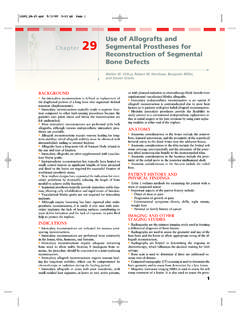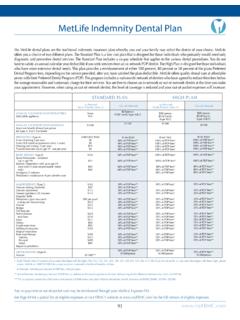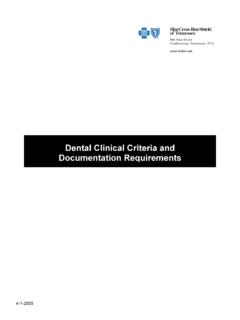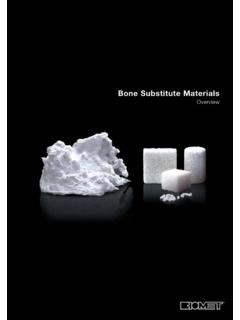Transcription of The cracked tooth conundrum: Terminology, …
1 _____ Review Article _____ The cracked tooth conundrum : terminology , classification, diagnosis, and management WILLIAM KAHLER, MSCDENT, DCLINDENT, FRACDS ABSTRACT: Purpose: To provide an overview of the clinical features, diagnosis, classification and management of cracked teeth which may be a diagnostic challenge in clinical practice. Results: Cracks may initiate from coronal tooth structure or from within the root and affect healthy or root treated teeth. There are many terminologies and classifications in the literature for cracked teeth that can be as confusing as the array of clinical symptoms which are associated with this condition.
2 The term cracked tooth syndrome is misleading as there are a range of symptoms that do not form a distinct and reliable pattern. Symptoms will vary with teeth that have healthy pulps, for teeth with inflamed or necrotic pulps, and for teeth that have been root treated. The American Association of Endodontists have classified five specific variations of cracked teeth; craze line, fractured cusp, cracked tooth , split tooth , and vertical root fracture. The importance of differentiating dentin, pulpal and periodontal pain for diagnosis and treatment for these specific entities will be elaborated. A decision flow chart indicating the treatment options available is presented.
3 (Am J Dent 2008;21:275-282). CLINICAL SIGNIFICANCE: A cracked tooth should be considered in the diagnosis of teeth which are sensitive to bite and thermal change. The American Association of Endodontists classification of cracked teeth is useful, though non-vital and root filled cracked teeth and teeth with periapical pathosis should be also considered in forming a diagnosis. : Dr. William Kahler, University of Queensland, Dental School, 200 Turbot St., Brisbane, 4000 Australia. E- : Introduction cracked or incompletely fractured teeth can become symptomatic. Patients often present with a protracted history of pain of varying intensity; the origin of which may be difficult to locate.
4 While intermittent pain on biting is the most consistent complaint associated with these teeth, cracks in teeth may result in a wide range of symptoms ranging from occasional discom-fort to severe and prolonged pain. Symptoms are often depen-dent on the depth and direction of the crack and the tissues involved. Cracks in teeth may occur in both horizontal and vertical directions involving the crown and/or root. The etiology is generally a result of occlusal forces and iatrogenic Crown and crown-root fractures are usually incomplete frac-tures commencing in the crown of posterior teeth from an internal line angle at the floor of a restoration, and often involving a marginal ridge with the fracture extending in a mesiodistal direction.
5 The fracture commences in the crown and may terminate in the vicinity of the cemento-enamel junction or extend apically into the Vertical root frac-tures are longitudinally orientated fractures of the root that extend from the root canal to the These fractures are usually complete and extend a variable length along the root generally in a bucco-lingual direction and may extend into the ,8-10 This paper reviewed the literature for an appropriate classification for cracked teeth and to determine the symptoms and processes that allow for correct diagnosis and treatment.
6 terminology AND DEFINITION Many authors have proposed different terminologies and definitions for cracks in teeth (Table 1). Gibbs11 first described the clinical symptoms of incomplete fracture of posterior teeth involving the cusp, naming it cuspal fracture odontalgia . Cameron2,12 coined the term cracked tooth syndrome in describing signs and symptoms associated with cracked teeth. However, there is considerable overlap and confusion in these proposals. For instance, cracked tooth syndrome has been defined as an incomplete fracture of a vital posterior tooth involving the dentin and possibly the dental pulp 13 despite the fact that Cameron12 reported that only 75% of teeth with cracked tooth syndrome will have vital pulps.
7 Many authors confuse the terminology by illustrating teeth with cracked tooth syndrome which are in fact teeth with vertical root The term cracked tooth syndrome is misleading as there are a range of symptoms that do not form a distinct and reliable pattern. Symptoms will vary with teeth that have healthy pulps, for teeth with inflamed or necrotic pulps, and for teeth that have been root treated. Ellis15 defined incomplete tooth fracture as a fracture plane of unknown depth and direction passing through tooth structure that, if not already involving, may progress to communicate with the pulp and/or periodontal ligament.
8 Cracks in teeth can be found in symptomatic and asymptomatic teeth, and are an etiological factor in pulpal disease. This can be a direct result of fracture extension to involve the pulp chamber as bacteria have been reported to be present in cracks,16,17 or, indirectly via the microleakage of bacterial CLASSIFICATION Several authors have proposed classifications which are generally based on either the type or location of the crack, the direction and extent of the crack, and/or the risk of symptoms and/or pathological processes (Table 2). The American Association of Endodontists, in a document titled Cracking the cracked tooth Code 40 identified five types of cracks in teeth which can be viewed at http://www.
9 And are briefly des-cribed in Table 3. 276 Kahler American Journal of Dentistry, Vol. 21, No. 5, October, 2008 Table 1. terminology and definitions for cracks/fractures in teeth. _____ Year Author(s) terminology Definition _____ 1954 Gibbs11 Cuspal fracture odontalgia 1954 Thoma19 Fissured fracture A crack in the crown of the tooth 1957 Ritchey et al20 Incomplete tooth fracture 1957 Down21 Fissural fracture Fractures involving enamel and dentin without loss of tissue 1961 Sutton22 Crack lines A break in the continuity of the tooth revealed only by the presence of a visible transverse line 1962 Sutton23 Greenstick fractures A fracture line forms in a part of a tooth underlying a cusp 1964
10 Cameron2 cracked tooth syndrome 1972 Wiebusch24 Hairline fracture 1973 Hiatt3 Incomplete crown-root fracture 1974 Talim & Gohi25 Incomplete coronal fracture 1976 Silvestri26 Split-root syndrome 1977 Maxwell & Braly27 Incomplete tooth fracture A fracture of tooth structure which extends into dentin but in which the tooth remains grossly intact 1981 Andreasen28 Enamel infraction An incomplete fracture (crack)









